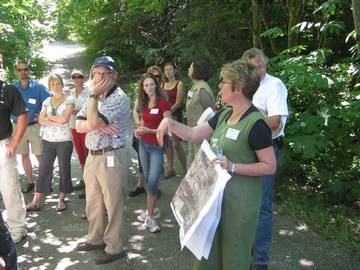Busy Place Creek in the Cowichan Valley is a pilot for a water-centric approach to land use planning
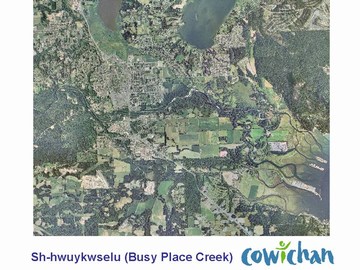
Pilot Plan for Water-Centric Approach to Land Planning
The Cowichan Valley Regional District is proceeding with development of a master drainage plan for Busy Place Creek. The plan is serving as a pilot process to inform a water-centric approach to land use planning. Furthermore, the process will also inform a regional policy framework for rainwater management and green infrastructure that protects stream health.
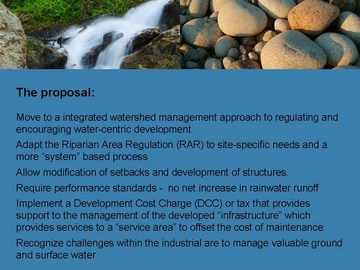
 According to Kate Miller, Environmental Manager, “This area of mixed land uses is a microcosm of the challenges and opportunities characteristic of the Cowichan Valley. As such, it provides an abundance of challenges and lessons learned. Teachable moments during the walkabout illustrated how upstream actions have downstream consequences.”
According to Kate Miller, Environmental Manager, “This area of mixed land uses is a microcosm of the challenges and opportunities characteristic of the Cowichan Valley. As such, it provides an abundance of challenges and lessons learned. Teachable moments during the walkabout illustrated how upstream actions have downstream consequences.”
The third and final seminar in the 2008 Cowichan Valley Learning Lunch Seminar Series was held on-site in the Busy Place Creek drainage area.
Performance Target Way-of-Thinking
“By holding the seminar in the heart of the Busy Place Creek drainage area, this  introduced an on-the-ground reality to the topic of performance targets,” adds Kim Stephens, Program Coordinator for the Water Sustainability Action Plan for British Columbia. ” We wanted to show participants why a performance target approach to land development makes sense, can meet multiple objectives, and thereby result in net environmental benefits at a watershed scale.
introduced an on-the-ground reality to the topic of performance targets,” adds Kim Stephens, Program Coordinator for the Water Sustainability Action Plan for British Columbia. ” We wanted to show participants why a performance target approach to land development makes sense, can meet multiple objectives, and thereby result in net environmental benefits at a watershed scale.
Busy Place Creek Walkabout
“Busy Place Creek is a small but complex watershed that is experiencing problems, and is under development pressure. Also, there are differences in stakeholder expectations from top to bottom. This mix provides lots of opportunities for policy development,” explained Kate Miller.

“Busy Place Creek originates in a residential area, passes through an agricultural area, then finds its way through another residential area before exiting into an industrial park located in a floodplain,” continued Kate Miller. “After that, it crosses the Island Highway and discharges into the Koksilah River which flows into the Strait of Georgia.”
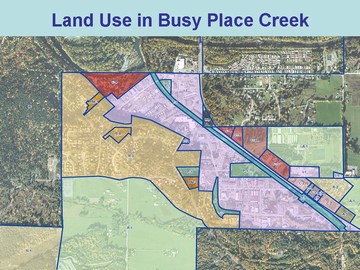

Below, Kate Miller describes the downstream impacts that resulted from increased flow in Busy Place Creek and a culvert failure at an access road crossing. To view a short video clip, click on the photo.
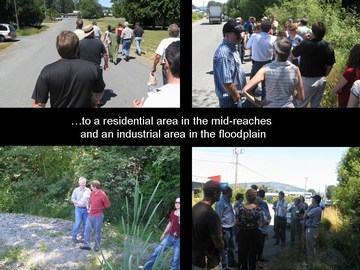
Local Examples Shape Expectations and Inform Policy
The key message flowing from the final group discussion after the walkabout was the importance of providing examples that illustrate expectations. “There are two types of examples, good and bad,” observed Peter Nilsen, Deputy Engineer  with the District of North Cowichan.
with the District of North Cowichan.
“While the bad examples allow us to state and show exactly what we don't want, they become counter-productive. An abundance of good local examples helps accelerate the changes in standard practices. So it is essential that local government and the development community align their efforts to produce examples that show exactly what we want our communities to look like.”
Showcasing Green Infrastructure Innovation
“This is precisely why we implemented the Showcasing Green Infrastructure Innovation program on both sides of the Georgia Basin,” added Kim Stephens. “Our experience is that once someone builds the first one, whatever that one may be, others will say what's the big deal, we can do that and we can do it better.”
The Goal: Build Regional Capacity
According to John Finnie, Chair of CAVI – Convening for Action on Vancouver Island which is responsible for both the Showcasing Innovation and Learning Lunch series: “The goal in showcasing innovation and celebrating successes is to promote networking, build regional capacity, and move ‘from awareness to action' 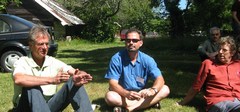 – through sharing of green infrastructure approaches, tools, experiences and lessons learned as an outcome of designing with nature.”
– through sharing of green infrastructure approaches, tools, experiences and lessons learned as an outcome of designing with nature.”
“There are a lot of good things happening throughout Vancouver Island. Yet practitioners in local government are not necessarily aware when they are being innovative and are not often aware of innovation in other municipalities,” continued John Finnie, “Because people are so busy in their own worlds, it takes a third party to connect them, just as we have done through the Learning Lunch Seminar Series. That is the role that CAVI plays.”

About the Vancouver Island Learning Lunch Seminar Series
The Learning Lunch Seminar Series promotes a consistent provincial approach to rainwater management and green infrastructure. In 2008, participating Vancouver Island local governments represented some 250,000 people.
- The Cowichan Valley series comprised a set of three sessions held during the June – July 2008 period.
- The C
omox Valley series comprised a set of three sessions held during the September – November 2008 period.
The Learning Lunch Seminar Series is the first step in building a regional team approach so that there will be a common understanding and consistent messaging regarding on-the-ground expectations for rainwater management and green infrastructure.

Posted January 2009


